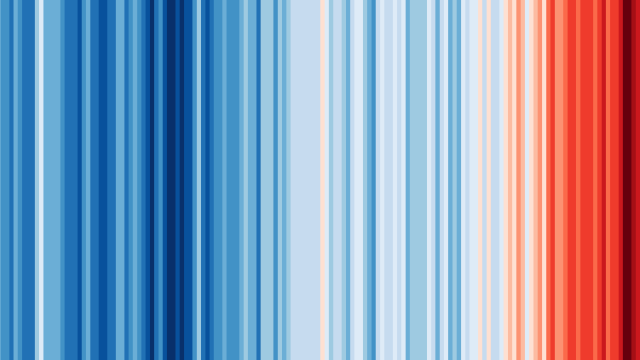When University of Reading climate scientist Ed Hawkins released his warming stripes visualisation for the globe last year, people freaked (in a good way). The minimalist graphic stripped out unnecessary clutter and told the story of global warming in blue and red stripes.
On Monday, Hawkins released a new website that allows users to create warming stripes for nearly every country, and even some cities and U.S. states. The data visualisations reveal a stark warming trend nearly everywhere, presenting an opportunity to shame your climate denying uncle who thinks a cold day disproves the climate crisis is afoot.
The warming stripes graphic takes the yearly average temperature departure from normal and visualizes it in a stark colour scale running from blue for cooler-than-normal to red for hotter-than-normal. The resulting visualisation shows the global warming signal clear as day. Following in the vein of an earlier visualisation where Hawkins depicted rising temperatures as a colour-changing spiral, it went viral. It also inspired a campaign by TV meteorologists to talk about climate change on the air.
But it also showed the global average temperature, which nobody experiences. The new iteration of warming stripes, however, helps bring things a little closer to home. Using data from Berkeley Earth as well as national meteorological agencies, the new stripes show how much individual countries have warmed. Some individuals countries like the tiny, scattered Cook Islands aren’t included, but most nations on Earth are there.
The resulting graphics illustrate that while there are fluctuations from place-to-place based on how much they’re influenced by natural climate patterns like, say, El Niño, climate change is slowly overwhelming those signals as it warms the planet. Here’s the annual average temperature departure from 1901-2018 for Australia, Barbados, and Turkmenistan, all of which showcase the planet’s increasingly hot and agitated state:
In places where the data is even richer, Hawkins’ site allows viewers to drill even deeper. Choose the U.S., for example, and you can see individual states’ warming trends. In Europe, some cities are available. Again, almost every visual is just different flavours of the same story: it’s getting hot. And if humanity doesn’t address its carbon emissions soon, it’s only going to get worse (and of course, there’s a graphic for that).
